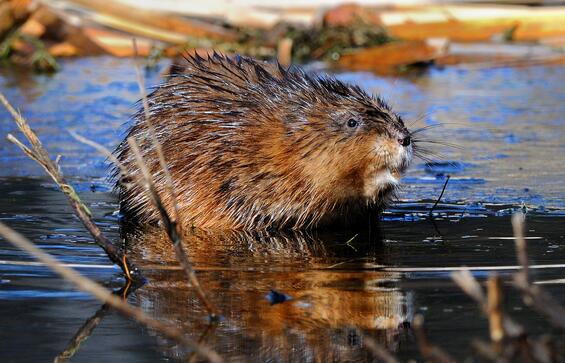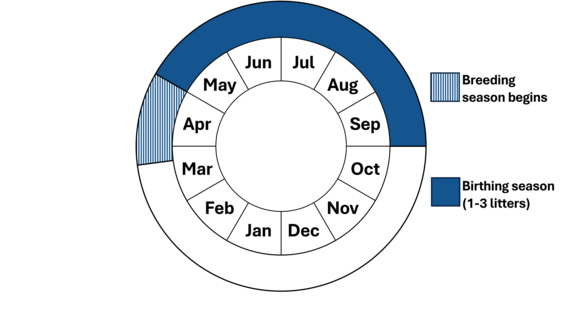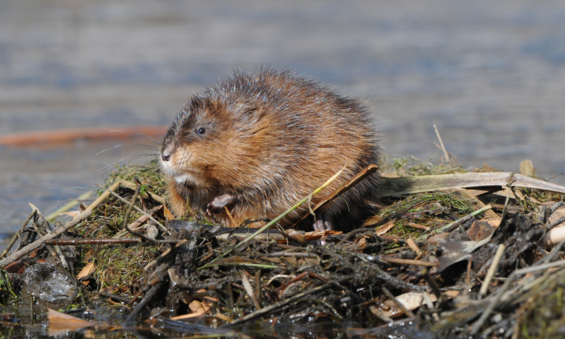- Scientific name: Ondatra zibethicus
- Species of Greatest Conservation Need (MA State Wildlife Action Plan)
Description

Muskrat (Ondatra zibethicus)
Muskrats are semi-aquatic rodents with dense, reddish to dark brown fur. The fur is made up of long, glossy guard hairs that overlay a dense layer of underfur that traps air and provides insulation and buoyancy while swimming. Adult muskrats weigh between 453–1,814 g (1–4 lb). Their body length is 40.6–63.5 cm (16–25 in), including a 17.8–30.5 cm (7–12 in) scaly, naked tail. Their tail is vertically flattened and comes to a point at the end, which provides balance on land and steering in the water. Muskrats have small eyes and ears and webbed hind feet.
Life cycle and behavior
Muskrats primarily feeding on aquatic and terrestrial vegetation but will also consume freshwater mussels, snails, crayfish, frogs, and insects. Muskrats tunnel into banks to create elaborate burrows with multiple chambers. These burrows can be up to 13.7 m (45 ft) long and may be used for multiple generations. They are mostly nocturnal but can be active at dawn and dusk and are often spotted during the day. Muskrats are active year-round in Massachusetts but will burrow deeper in the winter.
Muskrats form monogamous pairs as adults. The pair will actively defend their territory from other muskrats. Muskrats are capable for breeding throughout the year, however in northern environments breeding is tied to ice free conditions. In Massachusetts, muskrat breeding season begins in late March or April. Depending on habitat quality and population density, the female can give birth to 1–3 litters of 5–10 young per year between late spring into early fall. The young are weaned in less than a month but will typically remain in their mother’s territory until the following spring.

This graphic represents the peak timing of life events for muskrat in Massachusetts. Variation may occur across individuals and their range.
Population status
Muskrats are common throughout Massachusetts, but populations have been declining range-wide for more than 10 years.
Distribution and abundance
Muskrats can be found throughout Canada and the continental United States except for extreme northern areas, the arid areas of southwestern U.S., and portions of southeastern U.S. Regionally, muskrats are relatively common in New England. They are currently found across Massachusetts, including Martha’s Vineyard and Nomans Land islands, Naushon island, and Monomoy island.
Habitat
Muskrats live in wet environments with 1.2–1.8 m (4–6 ft) of water. They can be found in ponds, lakes, open swamps, and slow-moving sections of rivers and lowland streams but they tend to prefer marshes due to their constant water level. Muskrats can persist in urban, suburban, and rural environments.
Healthy habitats are vital for supporting native wildlife and plants. Explore habitats and learn about conservation and restoration in Massachusetts.

Threats
Muskrat populations have been experiencing broad-scale declines across North America over the last 10 years. Multiple studies are proposed and underway to determine the cause of these significant declines in populations. Potential impacts are habitat and wetland degradation, changing hydrology, invasive species (phragmites, knotweed) in wetland habitats, increases in avian and terrestrial predator populations, disease, and water quality and contamination. Increased frequencies of drought associated with climate change could result in a decrease in habitat quantity and suitability for muskrat as wetland areas may dry out more consistently.
Conservation
A proposed study is looking to test two potential causes of muskrat population decline in New England: the impact of the invasive phragmites in wetlands and the increased changes in water levels from human regulation and climate change. The project may also examine the effect of harmful algal blooms on muskrat presence/absence. If funded, an additional study will assess whether there are pathogen and toxicant threats to muskrats in the eastern United States that would impact their reproductive success, health, or survival. The identification of the underlying declines in muskrat populations is essential as the species provides numerous ecological, economic, and recreational services.
References
Cardoza, J.E., T.F. French, and G.S. Jones. Mammals of Massachusetts, with reference to other New England States. Northeastern Naturalist, accepted and under review.
Feldhamer, B.C. Thompson, and J.A. Chapman (eds.) Wild Mammals of North America: Biology, Management, and Conservation, 2nd edition. Johns Hopkins University Press, Baltimore, Maryland, 2003.
Contact
| Date published: | May 1, 2025 |
|---|